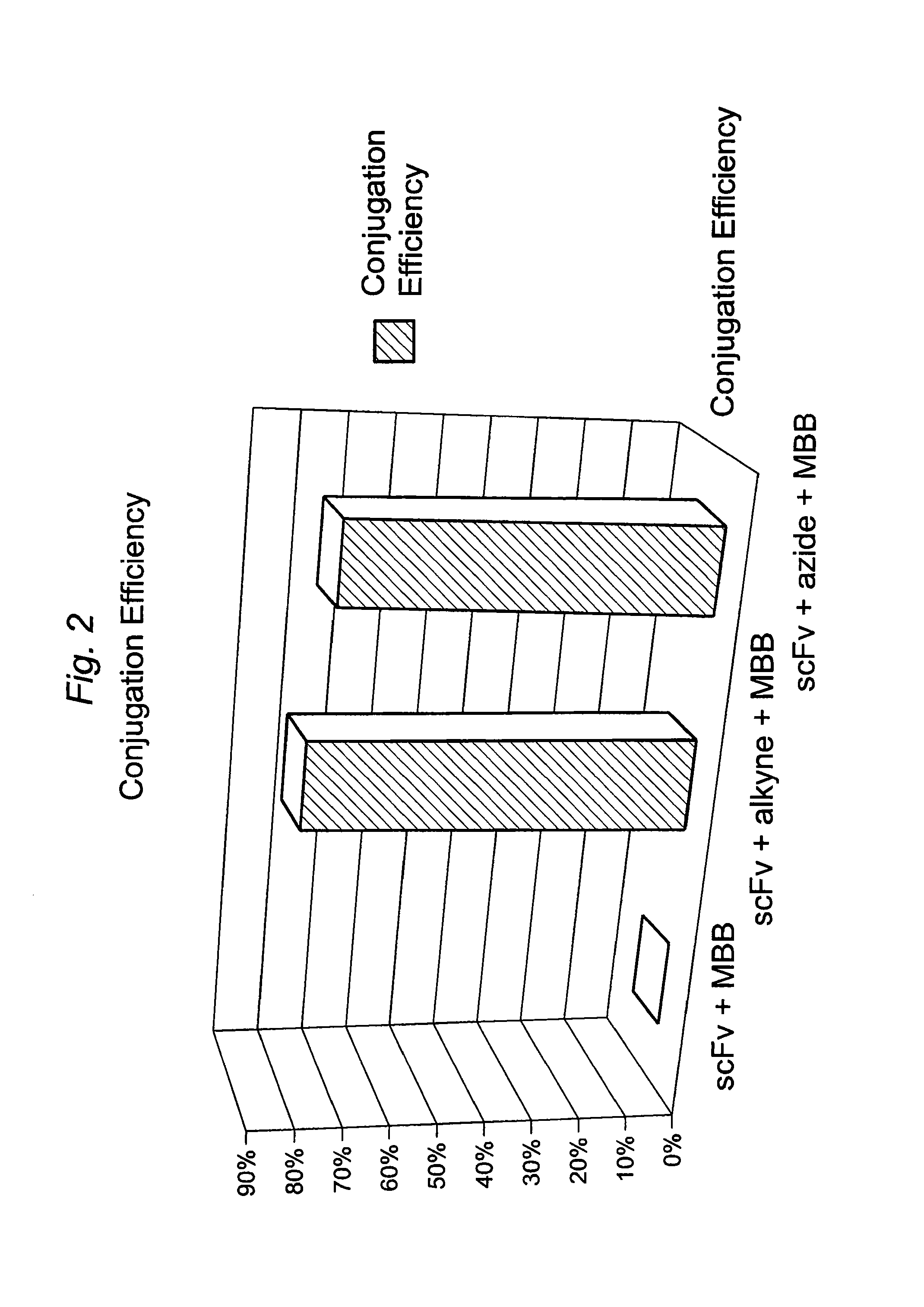Construction of a multivalent scFv through alkyne-azide 1,3-dipolar cycloaddition
a technology of alkyneazide and scfv, which is applied in the field of multivalent scfv through alkyneazide 1, 3dipolar cycloaddition, can solve the problems of limited clinical application, limited methods for producing multivalent scfvs, and inability to reach the central portion of the tumor with intact antibody constructs
- Summary
- Abstract
- Description
- Claims
- Application Information
AI Technical Summary
Problems solved by technology
Method used
Image
Examples
example 1
Synthesis of 2-Bromo-N-{2-[2-(2-prop-2-ynyloxy-ethoxy)-ethoxy]-ethyl}-acetamide (5)
[0098]
[0099]2-[2-(2-azidoethoxy)ethoxy]ethanol (2): In a 250 mL flask, 2-[2-(2-chloroethoxy)ethoxy]ethanol (1) (6000 mg, 35.7 mmol), NaN3 (6964 mg, 107 mmol) and tetrabutylammonium iodide (TBAI) (656 mg, 1.7 mmol) were added to 80 mL DMF. The temperature was slowly raised to 120° C. and the reaction mixture was stirred under argon overnight. The solvent was evaporated and the residue was purified by FCC to afford 2 as slightly yellow oil (4150 mg, 66%). 1H NMR (400 MHz, CDCl3): δ 3.29 (t, J=5.2 Hz, 2H), 3.50 (m, 2H), 3.57-3.64 (m, 8H). 13C NMR (100 MHz, CDCl3): δ 50.59, 61.60, 69.98, 70.34, 70.59, 72.56.
[0100]3-(2-(2-(2-azidoethoxy)ethoxy)ethoxy)prop-1-yne (3): in a 50 mL flask, 2 (350 mg, 2 mmol) was dissolved in 10 mL DMF. NaH (58 mg, 2.4 mmol) and subsequently propargyl bromide (476 mg, 4.0 mmol) were added to the reaction mixture. The reaction mixture was stirred at rt (room temperature) overnight...
example 2
Synthesis of N-{2-[2-(2-Azido-ethoxy)-ethoxy]-ethyl}-2-bromo-acetamide (8)
[0103]
[0104]Preparation of Triflic Azide (TfN3): To a solution of NaN3 (3445 mg, 53 mmol) in H2O (12 mL) was added CH2Cl2 (18 mL). The resulting biphasic mixture was cooled in an ice bath and stirred vigorously and treated with Tf2O (3000 mg, 106 mmol) over a period of 60 min. The reaction mixture was stirred in an ice bath for 4 h. The organic phase was separated and the aqueous phase was extracted once with CH2Cl2 (20 mL). The organic extracts were washed with saturated Na2CO3 solution and used without further purification.
[0105]2-(2-(2-azidoethoxy)ethoxy)ethanamine (7): 2-(2-(2-aminoethoxy)ethoxy)ethanamine (6) (3137 mg, 21.2 mmol) was dissolved in 10 mL of MeOH and treated with potassium carbonate (1698 mg, 63 mmol) and CuSO4 pentahydrate (14 mg, 0.088 mmol). The TfN3 solution was added dropwise over a period of 8 hr. The reaction was stirred for 18 h and the solvent was removed. Purification of the crude ...
example 3
[0107]
[0108]1,3-[bis(2-(2-(2-azidoethoxy)ethoxy)ethyl)]urea (9): 1,1-carbonyldiimidazole (37 mg, 0.22 mmol) and triethyl amine (TEA) (74 mg, 0.57 mmol) were added to 10 mL DMF. Under stirring, compound 7 (100 mg, 0.57 mmol) was added. The reaction mixture was stirred at rt overnight. The solvent was evaporated and the residue was purified by FCC to afford 9 as slightly yellow oil (81 mg, quant.). 1H NMR (400 MHz, CDCl3): δ 3.33 (t, J=5.2 Hz, 4H), 3.38 (t, J=5.2 Hz, 4H), 3.5 (t, J=5.2 Hz, 4H), 3.60-3.66 (m, 16H), 7.01 (bs, 2H). 13C NMR (100 MHz, CDCl3): δ 40.47, 50.86, 70.10, 70.17, 70.35, 70.61, 70.67, 70.77, 159.28. ESIMS calcd for C13H26N8NaO5 [M+Na]+ 397.39, found: 397.67.
PUM
| Property | Measurement | Unit |
|---|---|---|
| molecular weight | aaaaa | aaaaa |
| temperature | aaaaa | aaaaa |
| temperature | aaaaa | aaaaa |
Abstract
Description
Claims
Application Information
 Login to View More
Login to View More - R&D
- Intellectual Property
- Life Sciences
- Materials
- Tech Scout
- Unparalleled Data Quality
- Higher Quality Content
- 60% Fewer Hallucinations
Browse by: Latest US Patents, China's latest patents, Technical Efficacy Thesaurus, Application Domain, Technology Topic, Popular Technical Reports.
© 2025 PatSnap. All rights reserved.Legal|Privacy policy|Modern Slavery Act Transparency Statement|Sitemap|About US| Contact US: help@patsnap.com



